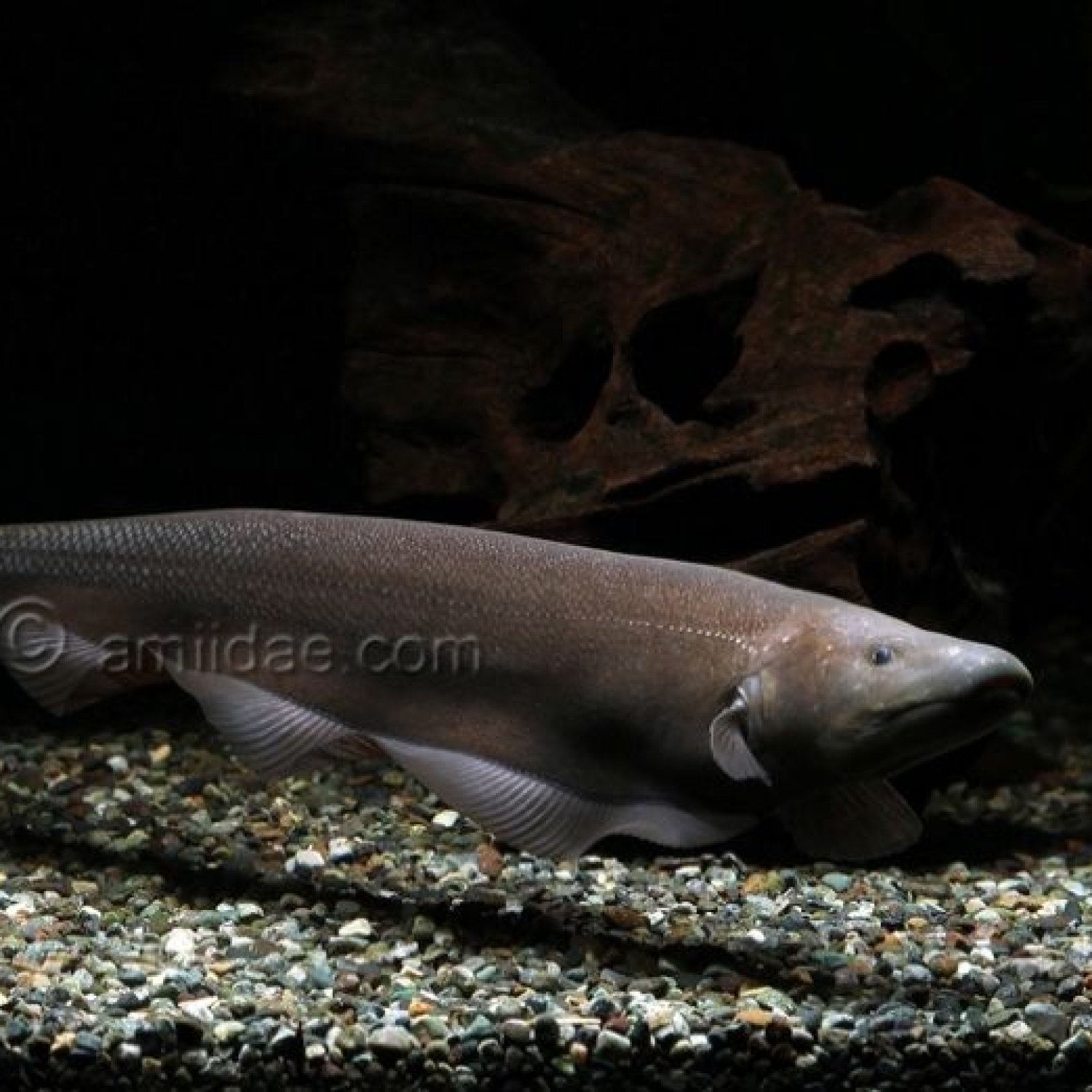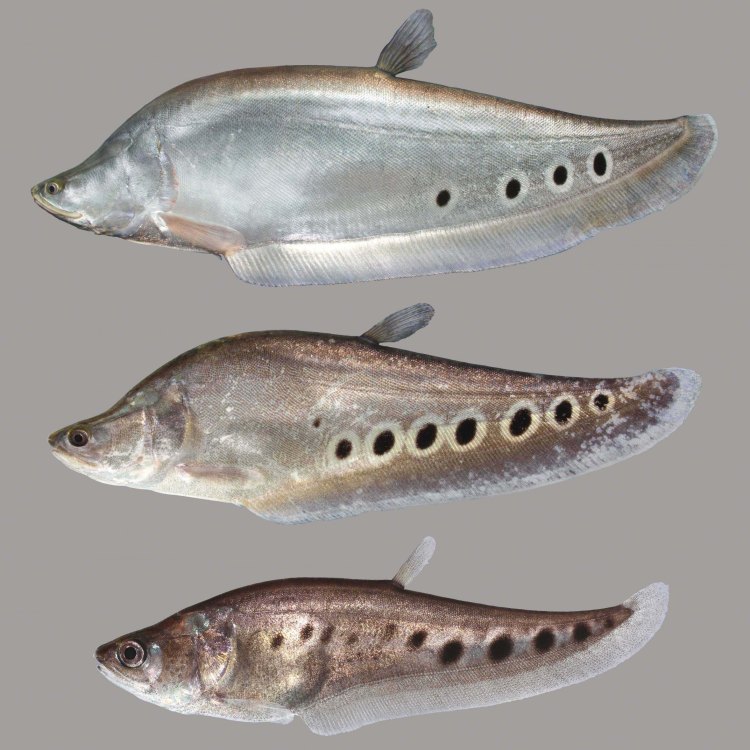
Knifefish
Varies depending on the species, ranging from a few inches to several feet
Knifefish are unique and fascinating animals found in South and Central America. With an elongated and cylindrical body, they can vary in length from just a few inches to several feet! There are various species of knifefish, making each one distinctive in its own way. Keep an eye out for these intriguing creatures on your next trip to the Amazon or other regions in South and Central America.
Animal Details Summary:
Common Name: Knifefish
Kingdom: Animalia
Habitat: Freshwater rivers, lakes, and streams
Discovering the Mysteries of the Enigmatic Knifefish
In the vast and diverse world of aquatic creatures, there is one that has long intrigued scientists and enthusiasts alike – the knifefish. This unique freshwater creature belongs to the Gymnotiformes order and can be found in the rivers, lakes, and streams of South and Central America. Also known as the "Ghost of the Amazon," this fascinating animal has captured the imagination of many with its elusive nature and extraordinary features.The Family Tree: Classification and Habitat of Knifefish
The knifefish belongs to the family Gymnotiformes, which includes over 200 different species Knifefish. They are a diverse group of freshwater fish and can be found in various habitats across South and Central America. These incredible creatures can be found in countries such as Brazil, Colombia, Argentina, and many others.Knifefish are classified under the kingdom Animalia, phylum Chordata, and class Actinopterygii, making them distant relatives of other fish such as salmon, trout, and catfish. But what sets them apart is their unique order, Gymnotiformes, which dates back to over 100 million years. They have evolved into incredible creatures with the ability to generate and detect electric fields, making them one of the most intriguing creatures in the aquatic world.
Appearance and Behavior of Knifefish
At first glance, the knifefish may not seem like anything extraordinary, but upon closer inspection, their unique features become apparent. They have an elongated and cylindrical body, with a flat, sharp head resembling a knife, hence their name. Their body shape enables them to glide smoothly through the water, making minimal noise and disturbance.One of the most fascinating abilities of knifefish is their electric organ, called an electric organ discharge (EOD), which they use for communication, navigation, and hunting Keagle. This electric field is generated by thousands of electric cells in their body, making the knifefish a living battery. They can also detect any external electric fields, including those of their prey, using a specialized organ called the ampullae of Lorenzini.
Just like their electric abilities, the knifefish is also a master of disguise with its coloration. They have a variety of colors, including brown, gray, black, and even iridescent scales, making them nearly invisible in their natural habitat. This serves as a defense mechanism against predators and helps them sneak up on their prey.
Diet and Predatory Behavior
The knifefish is a predatory species, and their diet is primarily composed of small invertebrates, insects, and other small fish. They have a keen sense of smell and can detect even the slightest movements in the water thanks to their electrical capabilities. Their electric field also helps them locate potential prey hiding under the sand or in the sediment.Once prey is detected, the knifefish rapidly moves its jaws to create a sudden flow of water, which immobilizes its prey. It then uses its sharp, pointed teeth to capture and consume its meal. These carnivorous fish can be quite aggressive in their hunting, and they have even been observed leaping out of the water to capture flying insects above.
A Hidden World: Knifefish in the Wild
The knifefish can be found in various freshwater habitats, including rivers, lakes, and streams. They are generally nocturnal, and like most creatures, they have specific behaviors and habits in the wild. Unfortunately, due to their elusive nature, not much is known about their day-to-day lives in the wild, and researchers are still uncovering new information about these fascinating creatures.One of the most intriguing behaviors of knifefish is their night-time activity patterns. Some species have been observed diving deep into the water to hide during the day and then swimming at the surface during the night. This behavior is thought to be a defense mechanism against predators, as the electric fields of knifefish become less detectable at deeper depths.
Despite being a solitary species, knifefish have been seen in schools during feeding times or during the breeding season. They are generally peaceful creatures and avoid confrontation, but they can become territorial during mating or if they feel threatened.
Human Interaction and Conservation
While the knifefish may seem like a common sight in the rivers and lakes of South and Central America, their numbers are dwindling due to various factors, such as habitat destruction and overfishing. Some species, such as the electric eel (Electrophorus electricus), have been widely exploited for their electric abilities, which has resulted in their decline in numbers.Conservation efforts are being implemented to protect these unique creatures, and in some countries, fishing of certain knifefish species is regulated or prohibited. Their elusive nature and ability to live in various habitats make it challenging to assess their population size accurately, making it vital to take precautionary measures to protect their species.
Uncovering the Wonders of Knifefish Through Research
Despite being studied for over a century, there are still many mysteries surrounding the knifefish that are yet to be discovered. Research is ongoing, and new information about their behaviors, abilities, and ecology is continuously being uncovered.One area of particular interest is the electric abilities of these unique creatures. Scientists are looking into how they generate and detect electric fields, and how they use this ability for communication and navigation in the wild. This knowledge could also have significant implications in the field of robotics and medical technology.
Another area of research is the diversity of knifefish species, as there is still a lot to be learned about the number of species and their relationships to one another. As more species are discovered, it is crucial to study their distribution and behavior to better understand and conserve these fascinating creatures.
A Final Word on Knifefish
From their electrifying abilities to their elusive nature, the knifefish is truly a one-of-a-kind creature. As we continue to learn more about these intriguing fish, we gain a deeper understanding and appreciation for the complexities of the natural world. It is crucial to protect and preserve their habitat and species for future generations to continue to marvel at their enigmatic ways. So next time you see a knifefish gliding through the water, take a moment to appreciate the wonders of this mysterious aquatic creature.

Knifefish
Animal Details Knifefish - Scientific Name: Gymnotiformes
- Category: Animals K
- Scientific Name: Gymnotiformes
- Common Name: Knifefish
- Kingdom: Animalia
- Phylum: Chordata
- Class: Actinopterygii
- Order: Gymnotiformes
- Family: Various
- Habitat: Freshwater rivers, lakes, and streams
- Feeding Method: Predatory
- Geographical Distribution: South and Central America
- Country of Origin: Various
- Location: South and Central America
- Animal Coloration: Various colors including brown, gray, and black
- Body Shape: Elongated and cylindrical
- Length: Varies depending on the species, ranging from a few inches to several feet

Knifefish
- Adult Size: Varies depending on the species, ranging from a few inches to several feet
- Average Lifespan: Typically 5-10 years, but some species can live up to 20 years
- Reproduction: Sexual
- Reproductive Behavior: Varies depending on the species, some are egg-layers while others are livebearers
- Sound or Call: Some species can produce electric signals for communication and navigation
- Migration Pattern: Varies depending on the species
- Social Groups: Solitary or form small groups
- Behavior: Nocturnal, generally peaceful, but can be territorial
- Threats: Habitat loss, pollution, overfishing
- Conservation Status: Varies depending on the species, some are of least concern while others are threatened or endangered
- Impact on Ecosystem: Important role in the food chain as both predator and prey
- Human Use: Some species are kept as aquarium pets
- Distinctive Features: Long, slender body with a characteristic knife-like shape
- Interesting Facts: Some species of knifefish are capable of generating electric fields to navigate and locate prey
- Predator: Larger fish and aquatic predators

Gymnotiformes
The Fascinating World of Knifefish: A Closer Look at Their Unique Features and Role in the Ecosystem
Deep in the murky waters of rivers and streams around the world, there lies a diverse group of fish known for their distinctive body shape and special abilities. These fish are commonly called knifefish, and they belong to the family Apteronotidae. Despite their common name, knifefish are not closely related to true eels or knife-like fish. Instead, they are a unique group of fish with fascinating features and habits that have captured the interest of researchers and aquarists alike PeaceOfAnimals.Com.In this article, we will take a closer look at the unique features and characteristics of knifefish, their role in the ecosystem, and the threats they face in the wild.
Size, Lifespan, and Reproduction
Knifefish species vary greatly in size, with some species growing to only a few inches while others can reach several feet in length. The average lifespan of knifefish is typically 5-10 years, with some species capable of living up to 20 years under optimal conditions.Like most fish, knifefish reproduce sexually. However, their reproductive behavior varies depending on the species. Some species are egg-layers, while others are livebearers. Egg-laying species typically lay their eggs in shallow waters near the riverbank, where the eggs can be protected from predators. On the other hand, livebearing species give birth to fully developed young, which can swim and hide from predators soon after birth.
Sound, Migration, and Social Behavior
Knifefish are not known for producing sounds or calls Komondor. However, some species, such as the apteronotid electric fish, can produce electric signals for communication and navigation. These electric fields are generated by specialized cells in their body called electrocytes. By altering the frequency and amplitude of these signals, knifefish can communicate with other individuals and navigate through their environment.Migration patterns of knifefish vary greatly depending on the species. Some species are migratory, traveling long distances to spawn or find better food sources, while others are non-migratory, staying within their local habitats.
Knifefish can be solitary or form small groups, depending on the species. They are generally peaceful and do not display aggressive behavior unless it is necessary for survival. However, they can be territorial, especially when it comes to defending their nesting sites.
Behavior, Habitat, and Threats
Knifefish are primarily nocturnal creatures, meaning they are most active at night. They have poor eyesight but rely on their highly developed sense of electroreception to navigate and locate prey in the dark waters. This special ability is what gives them their unique shape, with a long, slender body resembling a blade.These fish are generally shy and tend to hide in the day, seeking shelter among rocks, logs, and plants. They prefer slow-moving or still waters and are often found in rivers, streams, and flooded forests.
Like many aquatic species, knifefish face numerous threats to their survival. Habitat loss, pollution, and overfishing are some of the major concerns for their conservation. Dams, deforestation, and water pollution all disrupt their natural habitats, making it difficult for them to find suitable breeding and feeding grounds. Overfishing also poses a threat, as some species of knifefish are commercially exploited for their value in the aquarium trade.
Conservation Status and Ecosystem Importance
The conservation status of knifefish varies depending on the species. Some, like the black ghost knifefish, are listed as least concern, while others, such as the electric knifefish, are considered threatened or endangered. The decline in their population is mainly due to loss of habitat and human activities, such as pollution and overfishing.Despite their small size, knifefish play a crucial role in the ecosystem. As both predator and prey, they help maintain balance in the food chain. As predators, they feed on small invertebrates, fish, and insects, while as prey, they provide a food source for larger fish and aquatic predators.
Human Use and Interesting Facts
Some species of knifefish, like the black ghost knifefish and the glass knifefish, are kept as aquarium pets due to their unique appearance and behavior. However, proper care and maintenance are required to keep them healthy and happy in captivity. They need clean, well-oxygenated water and plenty of hiding places to feel secure.One of the most interesting facts about knifefish is their ability to generate electric fields. This unique adaptation not only helps them navigate and communicate but also enables them to locate prey in dark, murky waters. Some species, such as the electric knifefish, can produce enough electricity to stun their prey and defend themselves from predators.
Speaking of predators, knifefish themselves are preyed upon by larger fish and other aquatic predators, such as caimans and river otters. To defend themselves, they can generate powerful electric shocks to ward off potential threats.
Conclusion: Marvels of the River
In conclusion, knifefish are true marvels of the river, with their unique features and abilities making them stand out among other aquatic creatures. Despite the threats they face, these fish continue to thrive in their natural habitats, playing a crucial role in maintaining the delicate balance of the ecosystem. As stewards of the environment, it is our responsibility to ensure their survival and protection, so that future generations can continue to marvel at these fascinating fish.

Discovering the Mysteries of the Enigmatic Knifefish
Disclaimer: The content provided is for informational purposes only. We cannot guarantee the accuracy of the information on this page 100%. All information provided here may change without prior notice.












